1970 German Grand Prix race report
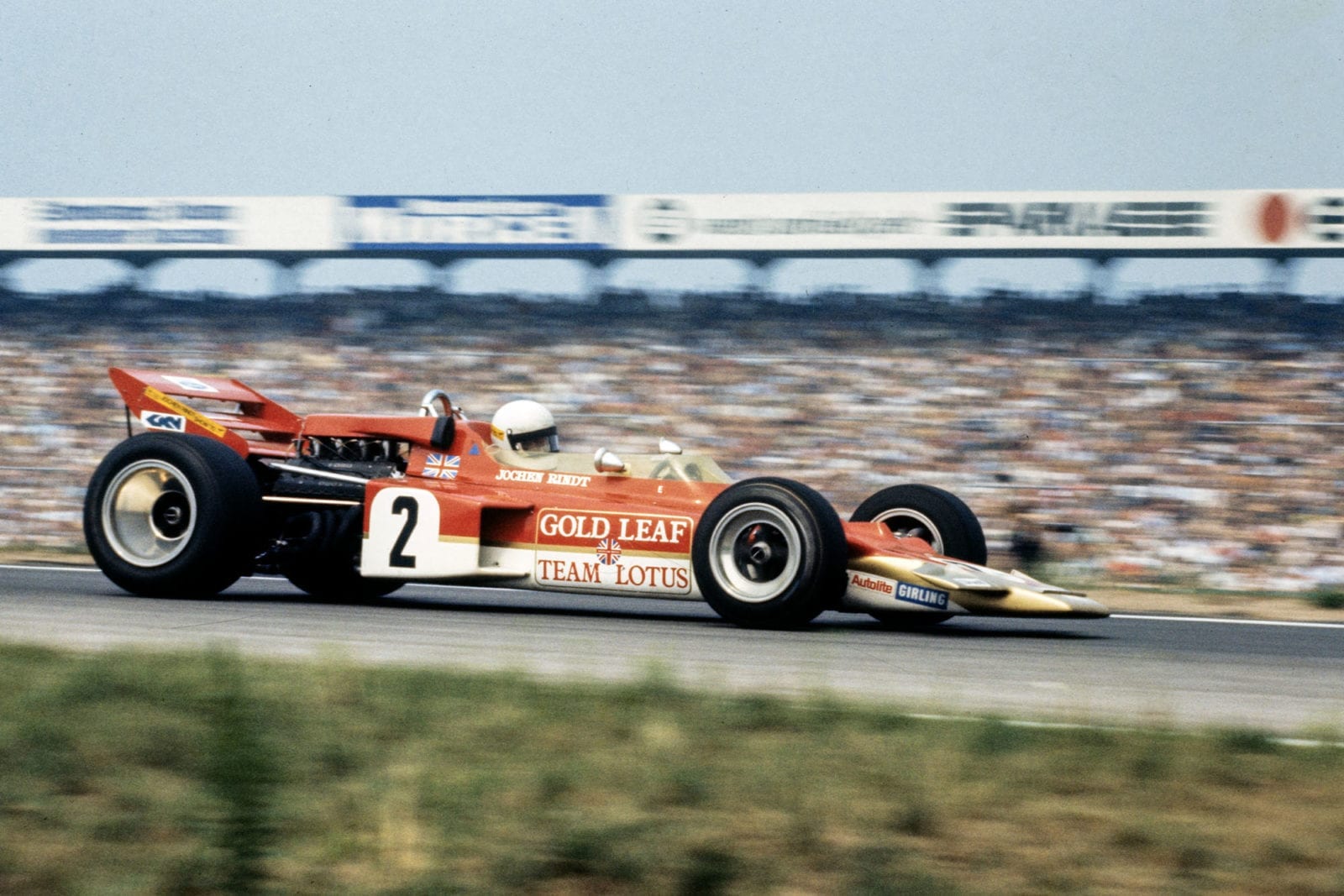
Lotus' Jochen Rindt won his fourth win in a row at the German Grand Prix
Motorsport Image
Fourth consecutive win for Rindt and Lotus 72
Putting aside luck or good fortune, the facts are that Rindt has now won four Grand Prix events in a row, driving the same Lotus 72 on each occasion. He ran away with the Dutch GP, when he first drove the completely modified Lotus 72, took command of the French GP when the faster Matra and Ferrari 12-cylinder cars dropped out, and won the British GP on the last corner when Brabham’s car ran short of petrol when leading. The four victories by the new Lotus 72 must indicate two things, one that it is the most successful of the Cosworth-powered cars and has lived up to the claims originally made by Colin Chapman and his chief designer Maurice Phillippe. The second thing is that Rindt is one of the fastest Grand Prix drivers active today (a fact no-one has ever disputed), and even if he has won two races with the Lotus 72 by reason of the misfortune of others, it is winning that counts in the long run and you must be near the front if you are going to profit from the misfortune of others. In the German Grand Prix, held on August 2nd on the Motordrom at Hockenheim, he won by a mere 0.7 sec. from Ickx (Ferrari flat-12), but the win was convincing as he was able to pass the Ferrari whenever he wished, thanks to the superior speed of the Lotus 72, and Ickx confirmed this fact. As was very evident at Zandvoort it was the Lotus 72 showing superiority over the other competitors, rather than the driver, and after the race Rindt gave confirmation of this, and did the same thing after the Hockenheim race. That the Ferraris were a strong challenge was shown by the newcomer Regazzoni challenging the leaders, and actually taking the lead on laps 22 and 23 of the 50-lap race, but gearbox trouble caused him to spin off the track when back in third place and he was forced to retire. Practice had indicated that these three were the main contenders for they were the only drivers to get below a 2-min. lap of the 6.78-kilometre circuit. There were no previous standards to go by for lap times, as this was the first Formula One race to be held at Hockenheim, and the previous fastest lap had been set by Bonnier with a Lola-Chevrolet in 2 min. 06.2 sec.
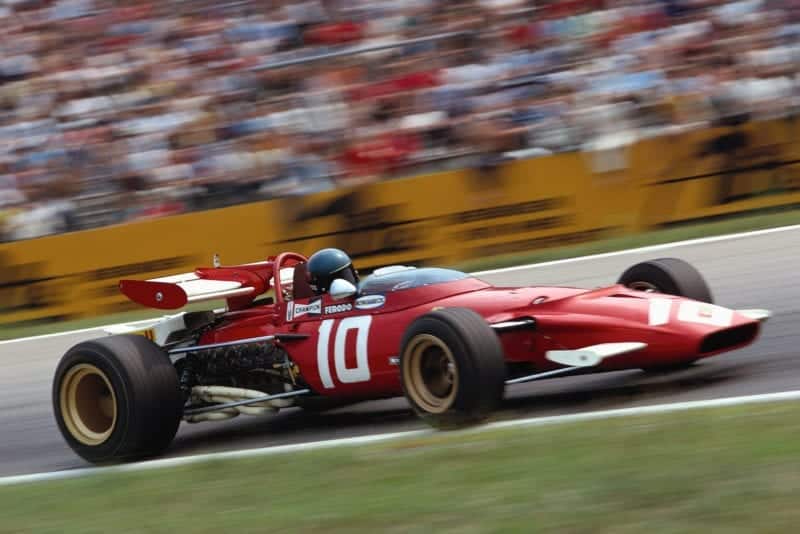
Jacky Ickx took pole for Ferrari
Motorsport Images
In the Friday practice Regazzoni lapped in 1min. 59.8 sec. to indicate that 2 min. was going to be bogey time, and in the first practice on Saturday Rindt did 1 min. 59.7 sec., to be beaten in the afternoon by Ickx with 1 min. 59.5 sec, Siffert was credited with 2 min. dead, but the general concensus of opinion was that it was an error by the time-keepers. As is becoming all too familiar, now that the 12-cylinder cars and the Lotus 72 are well under way, Stewart was barely in the picture, being only seventh fastest overall in practice, and nowhere in the race, his Cosworth engine giving trouble while lying near the end of the field, having dropped from a poor sixth place when his March 701 jumped out of gear and caused him to overshoot one of the “esses” out on the long straights. The BRM team were little better off, their 12-cylinder engines not being reliable or fast enough, so that neither Rodriguez nor Oliver could challenge the leaders, and for this race the third BRM team member, Eaton, was missing, having returned to Canada. While lckx was well-supported by his team-mate, Rindt had to battle alone, for Miles was not in the same class, even though he had a brand new Lotus 72 to the latest specifications, and the third member of the Gold Leaf Team Lotus team, Fittipaldi, is still learning about Formula One racing with an old Lotus 49C, but shaping up well with reliable and consistent driving, finishing fourth after moving up the field as others dropped out.
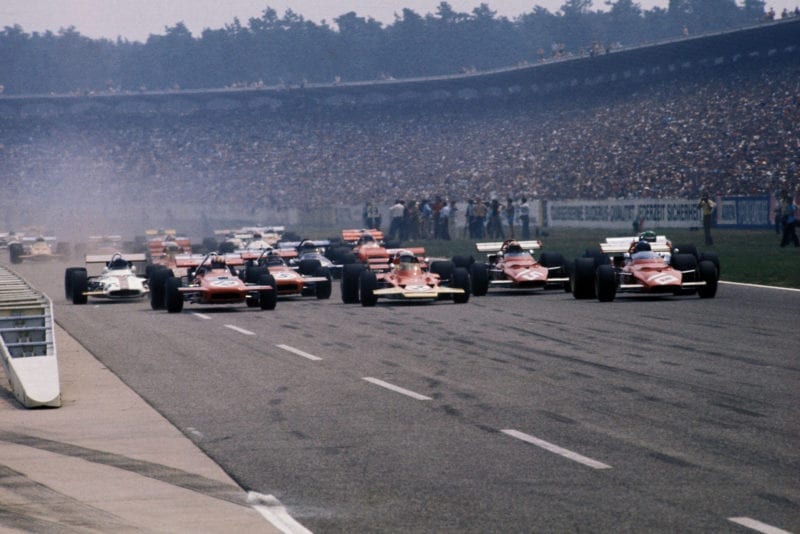
The race gets underway
Motorsport Images
Trouble with Cosworth V8 engines was rife throughout practice and the race, breakages varying from camshafts, through timing gears to crankshafts, while ignition units and injection units gave their share of trouble. Of the fifteen cars that started, using the standard British power-pack of Cosworth V8 engine and Hewland gearbox, only five finished, while nine retired with troubles connected with the engines and one with the gearbox. The odd car out was the STP-Oil Treatment Special of Andretti, or March 701/3 as we know it, and that had trouble with the gearbox selectors. Gurney was no longer with the McLaren team and his place was taken by Gethin, but neither he nor Hulme were fast enough to be contenders, their engines being down on power, while de Adamich with the Alfa-Romeo-engined McLaren failed once more to qualify for a place on the starting grid. However, by dint of consistency and just keeping going Hulme finished in third place, but nowhere near the leading pair, while Gethin stopped at the pits after the first lap, with his throttle slides sticking and only managed two more complete laps before retiring. The way Brabham shines at one meeting and fails miserably at the next is a bit of a mystery, and the German GP was a failure, he being uncompetitive in practice and then being left on the starting grid with an engine that would not fire and a gearbox that would not engage gear. His troubles were complete when his engine started to leak oil. Stommelen in the second works Brabham, a completely new monocoque after his Brands Hatch practice accident, was more fortunate and finished in fifth place after an unspectacular drive. The Matra-Simca cars were also in trouble, Beltoise having a lot of trouble with his engine leaking oil in practice, so that he missed the final practice session completely and started in last place on the grid. His race lasted no time at all for a lower front wishbone broke, but his team-mate finished in sixth place, after rising to fourth place as a result of retirements, his drop back being caused by trouble with fifth gear in the closing stages of the race and a quick pit-stop to report the fact.
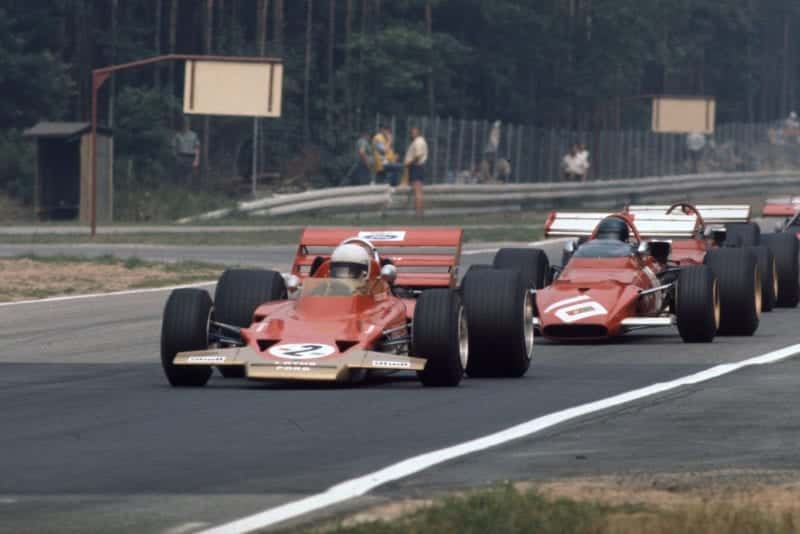
Rindt leads Ickx
Motorsport Images
The works March cars of Amon and Siffert both retired with engine troubles and the fact that Siffert could not stay near the front rather gave credence to the doubt about his 2-minute practice lap. The March 701 while being ready in numbers at the beginning of the season has made little progress and has been surpassed by the Lotus 72, the 312B Ferrari and the MS120 Matra-Simca, all three being new designs, whereas the 701 was a hastily designed affair using proven knowledge in order to get the new firm operational. There is no reason why the forthcoming March 711 should not be much more advanced and on a level with the 1970 designs. Meanwhile the team drivers and top drivers like Stewart and Andretti have to make do as best they can. Lesser March drivers like Peterson, Cevert and Hahne, the last-named making his debut with a brand new silver-painted car, are not affected so much as they are not yet at the driving limit of the 701. Surtees with his own car, the TS7, was no very high up on the grid after practice, but in th race moved steadily upwards until hi reached third place, only to lose it three laps from the end when his Cosworth V8 engine let him down yet again.
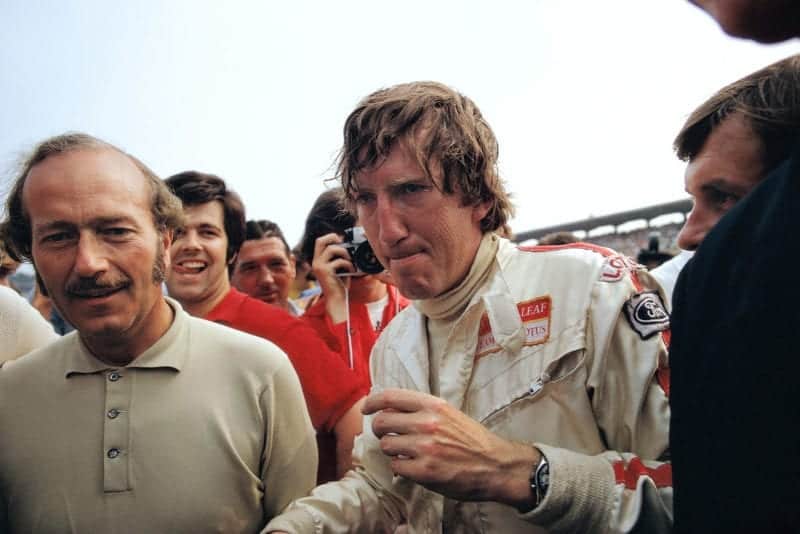
Jochen Rindt is congratulated by Lotus team boss Colin Chapman after winning
Motorsport Images
Viewing the German Grand Prix at Hockenheim from afar it would appear that those who had faith in the design ability of the Lotus team were not far wrong, nor were those who rate Rindt as one of the fastest drivers today. The flat-12-cylinder Ferrari when it was first seen at the end of last year looked to have good potential and it goes from strength to strength, while the Matra V12 is fulfilling the hopes of its designers, but the BRM V12 victory at Spa is now beginning to look like a “flash in the pan”. After three years of total domination the Cosworth V8 is struggling to retain its supremacy, but it is aided enormously by weight of numbers. It now looks certain that Stewart backed a loser by sticking to a Dunlop contract and getting Tyrrell to be the first customer for March, and this gave STP’s Any Granatelli and Mario Andretti false confidence, so that they also backed a loser, but they have done that before.
Notes on the cars at Hockenheim
The Tyrrell team had their usual three March 701 cars, with Stewart using 701/4 in the race and keeping 701/2 as a spare, while Cevert drove 701/7 as usual. Gold Leaf Team Lotus had the brand new 72C/R3, which Miles drive, Rindt retaining his usual car 72C/R2, the original Lotus 72 having been dismantled. R3 had a new stiffened monocoque on the liens of the modified R2 and the suspension layout without anti-dive on the front or anti-squat on the rear. Their third team member drove 49C/R10 that he used at Brands Hatch, most of its trouble in that race having been due to a split exhaust manifold. The Bruch McLaren Racing Team had done more shuffling around of parts, an entirely new and stiffer monocoque being made for Hulme, retaining the number M14A/2, so that the monocoque M14D/1 could revert to de Adamich and have all the Alfa-Romeo V8 bits put back on it, and Gethin took over M14A/I that Gurney had driven at Brands Hatch. The Motor Racing Developments team had built a new car for Stommelen, salvaging what they could off BT33/I and the new one was BT33/3, with inboard rear brakes as Brabham had first used on BT33/2 at Brands Hatch. The STP-March team remained unchanged, except for details of the rear suspension, but BRM produced yet another Type 153, number 06, and Rodriquez drove this in the race in preference to 153/05 which had been repaired since Brands Hatch. Oliver retained 153/04. The BRMs were fitted with tall oil tanks in an attempt to improve the lubrication system. The car that Pescarolo had crashed at Brands Hatch was being repaired so he appeared in MS120/02, which was yet another rebuild of parts from brands Hatch and Clermont-Ferrand. Beltoise retained MS120/3 as raced at Brands Hatch. The SEFAC Ferrari team had all three flat-12-cylinder cars at the circuit for pre-practice testing, with 001 and 003 for Ickx and 002 for Regazzoni, but a series of troubles with engines and gearboxes caused Ickx to use 003 in the race and Regazzoni 001, though 002 was assembled and ready in reserve on race morning.
For the rest it was a case of driving the one car they possessed, there being Surtees with the TS7/001, Hill with Lotus 49C/R7, Andretti with March 701/8, Redman with the De Tomaso 505/38/3, Moser with the Bellasi, and Hubert Hahne with the brand new March 701/9.
